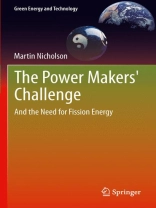The Power Makers – the producers of our electricity – must meet the demands of their customers while also addressing the threat of climate change. There are widely differing views about solutions to electricity generation in an emission constrained world. Some see the problem as relatively straight forward, requiring deep cuts in emissions now by improving energy efficiency, energy conservation and using only renewable resources. Many electricity industry engineers and scientists see the problem as being much more involved.
The Power Makers ’ Challenge: and the need for Fission Energy looks at why using only conventional renewable energy sources is not quite as simple as it seems. Following a general introduction to electricity and its distribution, the author quantifies the reductions needed in greenhouse gas emissions from the power sector in the face of ever increasing world demands for electricity. It provides some much needed background on the many energy sources available for producing electricity and discusses their advantages and limitations to meet both the emission reduction challenge and electricity demand.
By analyzing the three main groups of energy sources: renewable energy, fossil fuels and fission energy (nuclear power), readers can assess the ability of each group to meet the challenge of both reducing emissions and maintaining reliable supply at least cost. It is written for both non-technical and technical readers.
Inhaltsverzeichnis
What is Electricity?.- Faraday’s Miracle.- Poles and Wires.- The Balancing Act.- Dollars and Cents.- The Carbon Challenge.- Many Options.- Nature’s Curse.- Nature’s Saviours.- Storing Electricity.- Smoke and Mirrors.- Why Clean Coal?.- Baseload Alternatives.- Fission Not Combustion.- Safety First.- More Smoke and Mirrors.- Is Fission Really Necessary?.- The Next Generation of Fission.- Variable Loads Are Here to Stay.- Cost Matters.- Distributed Generation and Storage.- Smart Grids.- Electric Transport.- Summing It All Up.
Über den Autor
Martin Nicholson studied mathematics, engineering and electrical sciences at Cambridge University in the UK and graduated with a Masters degree in 1974. He has spent most of his working life as business owner and chief executive of a number of information technology companies in Australia. His first book, Energy in a Changing Climate, was first published in 2009.












